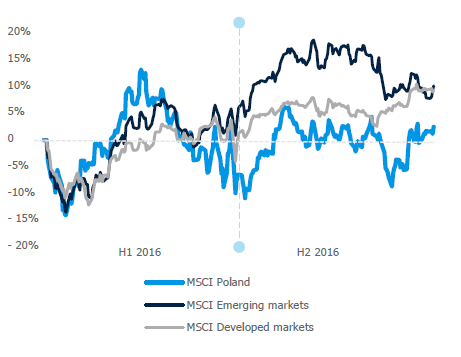In 2016, the domestic and global policy was the main factor determining the prices of shares and bonds.
In 2016, the domestic and global policy was the main factor determining the prices of shares and bonds. The capital markets were stimulated by the decisions of central banks to a lesser degree than in 2015. ECB (European Central Bank) and the Fed (United States Federal Reserve System) maintained a lax monetary policy and, additionally, market expectations indicated its milder than previously assessed.
In January of 2016, the Polish capital market was shaken up by the unprecedented decision of the S&P Global Ratings to lower Poland’s rating and assign a negative outlook.
In January of 2016, the Polish capital market was shaken up by the unprecedented decision of the S&P Global Ratings to lower Poland’s rating and assign a negative outlook. This entailed depreciation of the Polish currency (EUR denominated in PLN rose to its highest levels in 4 years), higher yield of Polish debt, and decreases on the stock exchange. In early December of 2016, S&P saw Poland in a more favorable light concerning areas like credibility of the economic policy and conditions of public finances and thus raised the rating outlook to stable.
WSE investors were worried by the announced reform of pillar II of the pension system (open pension funds) and successive scenarios concerning the banking system’s burden resulting from the revaluation of frank credits, which had a negative impact on the major Warsaw index WIG20 heavy weighted in banks.
In June of 2016, the global capital and currency markets experienced major turbulences associated with the United Kingdom’s decision to exit the European Union.
In June of 2016, the global capital and currency markets experienced major turbulences associated with the United Kingdom’s decision to exit the European Union. Furthermore, the situation on the Polish stock exchange did not benefit from global factors including, among others, concerns with the dynamics of further raise of interest rates by the Fed in the USA, the immigration crisis and its consequences in the European Union, the economic slowdown in China, the deteriorating situation in Russia, the continuing conflict in the Middle East, or the consequences of the attempted coup d’état in Turkey.
WIG/ Treasury bonds (10 years)

Source: Reuters
The end of 2016 saw an outflow of capital from treasury bonds and growths on the Polish stock market. After over one-year consolidation, the price of 10-year treasury bonds (profitability between 2.6%–3.3%) suddenly dropped and moved profitability up to 3.6% (quarter-on-quarter growth of 71 bps). During the same time, WIG20 saw the quarter-on- quarter growth of 13.9% to 1,947.92 points. The improving situation on the stock markets was supported by speculations on a potentially greater than expected stimulation of American economy (the so-called reflation, which assumes the existence of a fiscal impulse in the US which leads to acceleration of economic growth and increase of inflation, as well as simultaneous raise of interest rates by the Fed and growth in the profitability of US Treasury bonds) resulting from Donald Trump’s victory in the United States presidential election. See more
MSCI IMI*

* MSCI IMI, gross (USD): the index recognizes small, medium, and big companies and dividend reinvestments
Source: Reuters
In 2016, MSCI Poland presented high fluctuation when compared with the MSCI of Emerging Markets. The reasons included the weighing of the financial companies in this portfolio (47.6% at the end of 2016; including PZU weight of 9.9%), which experienced major pressure from e.g. statutory regulations. At the end of 2016, the MSCI of Emerging Markets rose by 10.3% year-on-year, i.e. by 1.5 p.p. more than the MSCI of developed markets. MSCI Poland also followed this trend and recorded growth of 3.2% year-on-year.
Correlation of WIG20 with MSCI Emerging Markets 05.2010-2016

Source: Reuters
The long-term correlation of WIG and MSCI of emerging markets (between May 2010 and the end of 2016) reached 88.9%. This factor was at 92.0% in 2015 and dropped to almost zero in 2016. Finally, by the end of 2016, the inflow of capital on the Polish exchange once again moved WIG20 closer to the MSCI of Emerging Markets once again.









